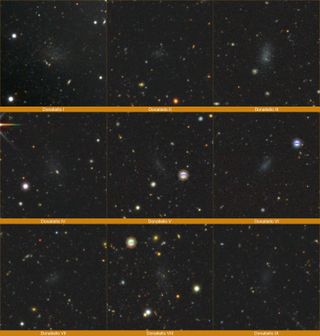Move over, professional astronomers – an amateur has entered the game and unearthed a treasure trove of cosmic bodies! Giuseppe Donatiello, a stargazing enthusiast from Italy, has achieved the remarkable feat of discovering five new dwarf galaxies orbiting a majestic spiral galaxy known as NGC 253.
What’s even more astonishing? These newfound galaxies now proudly bear Donatiello’s name – Donatiello V through Donatiello IX.
A Passionate Pursuit Leads to a Stellar Discovery
Donatiello’s journey began in 2016 when, with a keen eye and a dash of astrophotographic expertise, he spotted the first of these dwarf galaxies. This initial discovery, christened Donatiello I, paved the way for a series of remarkable finds, solidifying Donatiello’s place as the first and only amateur astronomer to have galaxies named after him.
Dwarf Galaxies: Tiny Titans with Big Secrets
These newly discovered dwarf galaxies, located a staggering 11.5 million light-years away, are more than just celestial oddities. Their faintness, coupled with their proximity to NGC 253, makes them invaluable for astronomers seeking to understand:
- The Formation of the First Stars: By studying these ancient, low-mass galaxies, scientists can glean insights into the conditions that led to the birth of the universe’s very first stars. These primordial crucibles likely lacked the heavier elements found in abundance in modern galaxies, suggesting a distinct set of physical processes governed the formation of the earliest stars.
- The Mysterious Dark Matter: Dwarf galaxies are thought to be brimming with dark matter, an invisible substance that exerts a gravitational pull, shaping the galaxies’ structures and influencing their motions. By analyzing the distribution of dwarf galaxies around larger galaxies like NGC 253, astronomers can learn more about the properties and behavior of dark matter, a substance that makes up a significant portion of the universe’s mass but remains undetectable by our current instruments.
- The Evolution of Galaxies: Unveiling the formation and evolution of dwarf galaxies helps us piece together the grand narrative of galactic growth and development. Dwarf galaxies may represent the building blocks of larger galaxies, merging over eons to form the majestic spirals and ellipticals that dominate the observable universe. Studying these dwarf galaxies provides a window into the early stages of galactic assembly and the complex processes that govern galactic evolution.
The Missing Satellite Problem: A Cosmic Puzzle
Donatiello’s discoveries contribute to a puzzling phenomenon known as the “missing satellite problem.” According to the prevailing cosmological model, Lambda-Cold Dark Matter (ΛCDM), galaxies like our Milky Way should be surrounded by hundreds, if not thousands, of dwarf satellite galaxies. However, observations reveal a far lower number. Donatiello’s relentless pursuit of these elusive dwarf galaxies helps us refine our understanding of this discrepancy. It’s possible that current detection methods simply aren’t sensitive enough to pick up on the faintest dwarf galaxies, or that the ΛCDM model needs some tweaking to account for the observed distribution of dwarf galaxies around larger galaxies.
Beyond the Naming Rights: A Quest for Knowledge
While having his name etched into the annals of astronomy is undoubtedly an honor, Donatiello’s true passion lies in the thrill of discovery. He, along with his team, is actively utilizing data from the Dark Energy Spectroscopic Instrument (DESI) to further explore the Sculptor galaxy group and its surroundings. Their focus is on uncovering even fainter dwarf galaxies that might be lurking in the shadows, potentially pushing the boundaries of our understanding of galactic formation and evolution.
The Future of Discovery: Powerful New Tools and Tireless Curiosity
Donatiello’s story exemplifies the transformative power of curiosity and the potential for groundbreaking discoveries in astronomy, even for amateur stargazers. As telescopes like the Vera C. Rubin Observatory come online with their immense light-gathering capabilities and advanced detection technologies, we can expect a surge in the detection of even fainter, more elusive celestial objects. Donatiello’s discoveries serve as a stepping stone, propelling us further into the uncharted territories of our cosmic neighborhood.

Whether these endeavors ultimately resolve the missing satellite problem or necessitate a paradigm shift in our understanding of the universe, one thing is certain: the pursuit of knowledge in the cosmos continues, fueled by the unwavering passion of both professional and amateur astronomers. Donatiello’s story is a testament to the fact that scientific discovery can be driven by anyone with a thirst for knowledge and the dedication to explore the universe’s countless mysteries.



















